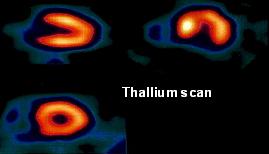Heart Tests: Radionuclide scan

This is a test which uses radiochemicals like thallium and technetium to locate areas of deficient blood flow in the heart. The subject does a treadmill stress. At the peak of the exercise, the radiochemical is injected into his vein and a special nuclear imaging camera is used to image the heart at different angles, to check the adequacy of blood flow. Areas of inadequate blood flow will show as areas of low radioactivity (cold areas), detected by the camera. Knowing the blood flow pattern in the heart, we can co-relate the areas of "cold areas" with the territory supplied by the respective arteries. In those subjects who cannot exercise, we can use drugs through IV injections, to induce regional lack of blood supply.
It is a very popular test for the diagnosis of CAD in the developed countries, where nuclear reactors are always nearby. Technetium has a longer half life and so can be transported and stored for longer. Thallium on the other hand has a short half life (72hrs) and cannot be stored for long. This does give logistics problems in trying to arrange the tests. For both agents, there is the additional problem of "radioactivity" stigma and also radioactive waste disposal. That may be why these tests are only available in few medical institutions, and therefore not so popular.
However, in theory, it is a very useful test as it does have predictive accuracy in the 90% range, in good centers, and it is relatively cheap. We use it sometimes to help us sort out those patients with an equivocal stress ECG, who also has some coronary risk factors. We call this group patients with intermediate risk factors and equivocal stress ECG result. The radio-nuclide scans are also very useful in those who cannot exercise.
For those who are following our series, the heart of the matter, this is part eighteen. Part 17 is here and our disclaimer is here. In the next part of the series we discuss the coronary angiogram.
No comments:
Post a Comment